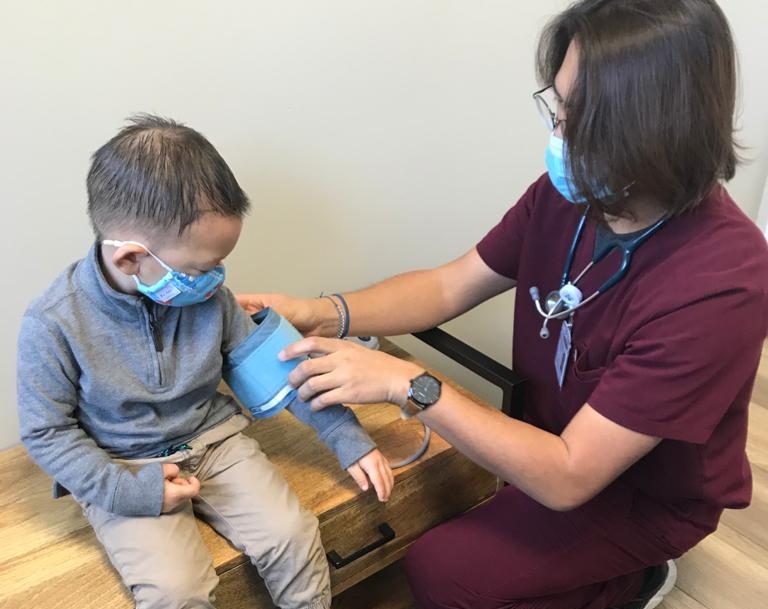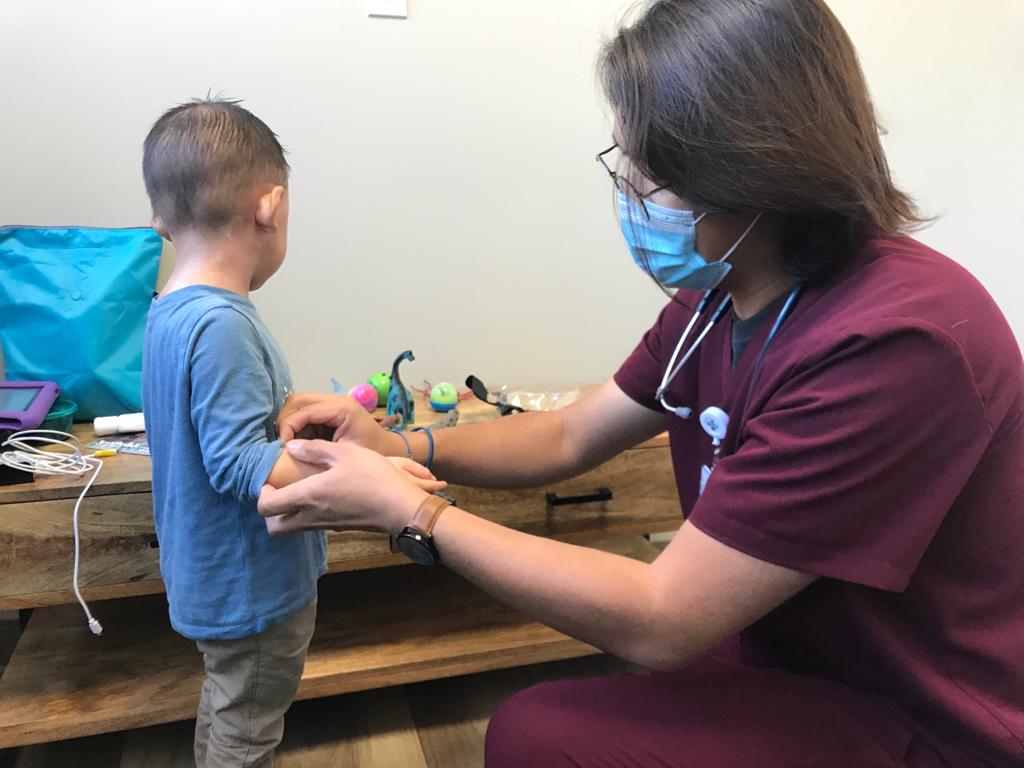Editor’s Note: This video is part of the ongoing allergy series in partnership with Columbia Allergy. To learn more about allergies, eczema, and related topics, please refer to our Allergy Guide!

Food allergies are on the rise, and besides being terrifying, they can also be a real hindrance to the quality of life – especially for our little ones. We have just embarked on the long, but promising, journey with oral immunotherapy (OIT) for our son. Even though we’ve already hit some speedbumps in the first few months of treatment, we are determined to see it through, because we know how positively life-changing the outcome would be. I’ve recently sat down with Dr. Jain of Columbia Allergy, a world-renowned allergist and immunologist, to talk about all the latest and much-needed allergy treatments available.
What are the available allergy treatments in the U.S. as of now?
The current standard for treatment of most food allergies in the US is avoidance of the food and use of epinephrine auto-injector to manage anaphylaxis. There is also a treatment recently approved by the FDA for peanut allergies. Palforzia [Peanut (Arachis hypogaea) Allergen Powder-dnfp] for children ages 4-17 years with a diagnosis of a peanut allergy. Palforzia treatment consists of three phases: Initial Dose Escalation, Up-Dosing, and Maintenance. The Initial Dose Escalation phase, and each up-dose must be administered at the clinic to monitor for severe allergic reactions. Additional treatment options for food allergies that are offered throughout the US but not regulated by the FDA include oral immunotherapy (OIT) and sublingual immunotherapy (SLIT).
What is OIT?
Oral Immunotherapy (OIT): Oral immunotherapy (OIT) is a desensitization treatment used to effectively treat even the most severe, or anaphylactic, food allergies. The goal of OIT is to safely reintroduce severe food allergies back into your diet through a desensitization process. This process starts with the patient eating a very small, microscopic amount of food in the office, and gradually increases the amount of food each time. At the end of each visit, the patient is given instructions to continue to eat a safe dose every day until the next appointment. This ongoing exposure to the allergen helps the body’s immune system to stop seeing the food as a threat and to stop triggering a significant allergic reaction every time that food is consumed.
How is OIT different from early food introductions, desensitization programs, sublingual treatments, and TIP?
Sublingual Immunotherapy (SLIT) is another desensitization treatment, but this one uses a custom fluid placed under the tongue to desensitize your immune system’s response to known food allergens. The tissues under your tongue, also known as the sublingual area, rapidly absorb the allergens directly into your bloodstream. SLIT works by exposing your immune system to controlled amounts of your food allergens. Over time, the immune system learns to not react to the allergens. As a result, your symptoms improve or completely go away. This desensitization treatment starts by introducing a very small amount of the food allergen in the office, and gradually increases the amount of allergen each time. The visit is closely monitored by medical staff to ensure the patient’s safety throughout the process. At the end of each visit, you will be given instructions to continue to take a safe dose every day until your next appointment. This ongoing exposure to the allergen helps your immune system to stop seeing the food as a threat and to stop triggering a significant allergic reaction every time you are exposed to the allergen(s). SLIT is typically used for the treatment of mild-moderate food allergies or as a starting point for anaphylactic allergies before progressing to OIT.
Early Food Introductions are a method to help prevent a child from developing a food allergy, but this does not treat an already existing food allergy. Many research studies proved that earlier introduction of peanuts and egg in average and high-risk individuals actually led to a lower percentage of patients developing food allergies when compared to the previous recommendation.
As the immune system is developing, we want to intentionally introduce highly allergenic foods and continue to regularly expose the immune system to these proteins so that the immune system is trained to recognize the proteins as “friendly” and not as a threat. This same idea is used in allergic patients to desensitize to a known allergen. If this window of opportunity is missed, the body may detect a peanut protein as foreign after an initial unintentional exposure through cross-contamination and develop antibodies against it early in infancy. If the next exposure to peanuts does not happen for some time, the peanut protein will not be something the immune system is used to and the body has time to develop a strong immune reaction to this substance resulting in an allergic reaction.
Tolerance Induction Program (TIP) is a desensitization treatment that is also commonly used to treat anaphylactic food allergies. This treatment process is almost identical to OIT. The major difference is that this specific program includes allergy testing and SLIT to be part of the process instead of individually labeling these tests and treatments as most other food allergy clinics do.
Can you walk us through the milestone stages of OIT?
-
-
-
OIT consult: The first visit to our clinic will consist of a consultation with one of our OIT providers to evaluate if you or your child is a candidate for this treatment. To make the most of this first visit, please bring past laboratory and skin testing results, a typed history of past allergic reactions, and all past relevant medical records. The provider will review this information and decide if further allergy testing is required before proceeding with OIT. All other medical histories will be discussed and reviewed at this appointment. Topics such as asthma and environmental allergies will be highlighted since it is recommended to have both under control prior to starting OIT. The visit will conclude with an allergy treatment plan. If you or your child has a severe or anaphylactic allergy to food, your allergist will likely recommend OIT. Most patients who undergo OIT come into the office weekly for 3-4 hour appointments (typically a morning session that starts right when the clinic opens, or an afternoon session that begins right after the lunch break).
-
 First OIT treatment appointment: The medical staff will start by reviewing the treatment process, obtaining consent, and collecting a history for the day. Next, vital signs are obtained along with an initial nursing assessment to get a baseline of all the body systems prior to starting treatment. If any concerns are noted during the initial assessment or with the vital signs, the provider will meet with your prior to starting treatment. The first OIT dose will be administered in the food provided by the patient. The person receiving the dose should then wash the dose down with water or another drink to make sure there is no residue left in the mouth. Vital signs will be checked and an assessment will be performed 20-30 minutes after each dose. Plan for doses to be administered every 20-60 minutes during the 3-4 hour appointment. After each dose, the patient will be monitored closely for any signs or symptoms of an allergic reaction. Parents and patients are instructed to notify staff immediately if any changes are detected. The patient will go home on the last tolerated dose and take this dose as instructed until their next appointment.
First OIT treatment appointment: The medical staff will start by reviewing the treatment process, obtaining consent, and collecting a history for the day. Next, vital signs are obtained along with an initial nursing assessment to get a baseline of all the body systems prior to starting treatment. If any concerns are noted during the initial assessment or with the vital signs, the provider will meet with your prior to starting treatment. The first OIT dose will be administered in the food provided by the patient. The person receiving the dose should then wash the dose down with water or another drink to make sure there is no residue left in the mouth. Vital signs will be checked and an assessment will be performed 20-30 minutes after each dose. Plan for doses to be administered every 20-60 minutes during the 3-4 hour appointment. After each dose, the patient will be monitored closely for any signs or symptoms of an allergic reaction. Parents and patients are instructed to notify staff immediately if any changes are detected. The patient will go home on the last tolerated dose and take this dose as instructed until their next appointment. -
Up-dosing stage: The frequency of visits will primarily vary depending on how well the patient tolerates updosing and their home doses and patient availability. These updosing appointments will be required until the patient reaches a maintenance dose, which can take as few as 3 months or as many as 12 months or beyond. These appointments proceed almost the same as the first OIT treatment appointment.
-
Maintenance stage: This stage indicates that a patient has reached the end of the OIT protocol and can now remain on a stable dosage long-term. Once in this stage, patients can expect to follow up with their provider at 1 month, 3 months, 6 months, and 1 year after reaching the maintenance dose. Annual visits are then recommended with allergy testing performed before the visit.
-
-
How does the risk of severe reaction differ between different treatments?
Any allergy desensitization treatment carries with it a risk for a severe allergic reaction. OIT and TIP can have the following risks: itching, hives, or abdominal pain, which can progress to more serious reactions including shortness of breath, wheezing, chest tightness, cough, swelling of the tongue, throat, lips, or other body parts, abdominal cramping, anaphylaxis, and death. In case of such a serious reaction, the patient may need to be transported to the hospital/Emergency Department. However, Columbia Allergy has several safety nets in place to mitigate this risk. At Columbia Allergy, OIT patients must stay in the clinic for one hour for observation after receiving the last dose of each visit, but even then a delayed reaction may occur after the ingestion challenge has been successfully completed. All patients are required to carry an EpiPen or EpiPen Jr. (or epinephrine auto-injector equivalents) at all times. In addition, frequent nursing assessments are performed and vital signs are frequently obtained to monitor for early signs of anaphylaxis. The office is equipped with the medication needed to treat allergic reactions. Dosing adjustments are made to minimize the chances of a reaction occurring. Severe allergic reactions are less commonly seen in SLIT since this is more commonly used to treat mild-moderate allergic reactions.
The information on this website is not intended or implied to be a substitute for professional medical advice, diagnosis, or treatment. All content, including text, graphics, images, and information, contained on or available through this website is for general information purposes only. Always seek the advice of your physician or other qualified health care provider with any questions you may have regarding a medical condition or treatment and before undertaking a new health care regimen. Never disregard professional medical advice or delay in seeking it because of something you have read on this website.
















